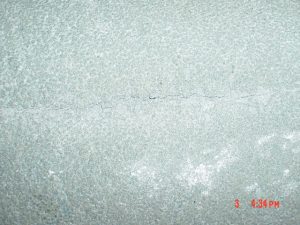Experienced centrifugal casters know that having the proper machinery is only part of the equation for achieving quality castings. Process and metallurgy also play a critical role. Defects can be machine related but can also be related to process.
A number of defects occur in centrifugal castings that may or may not occur in static casting. Defects can be related to Pouring, Spinning, Temperature, Material, or Coating.
In order for CCMCO to help solve process problems for our customers we need as much data to troubleshoot as possible.
Send a photograph if you have it and include detailed data. Some examples of data to include are:
- Size of casting.
- Location of defect. For example is it located all over the casting or specifically in one place.
- Alloy being poured.
- Degassing process being used.
- Coating type and application method.
- Pouring temperature.
- Initial spin speed and changes to spin speed once pouring is complete.
Hot Tears can occur across the circumference of the casting, or transversely across the casting. They are visible defects that can be caused by several different reasons. Hot Tears can occur in casting produced both vertically or horizontally. Hot Tears are sometimes referred to as cracks.
There are two main types of Hot Tears: Radial Hot Tears and Longitudinal Hot Tears
Radial Hot Tears
Radial Hot Tears are caused by the restricted longitudinal shrinkage during solidification and cooling time. These cracks are usually characterized by the zigzag fracture at the crack.
Possible Causes:
- The casting is not being cooled enough before extraction.
- The spinning speed is too high during solidification period.
- The mold bore diameter is uneven along the mold length.
- The mold was thickness is uneven along the mold length.
- Leaking endplates which can produce fins on both ends.
What to do:
- First, check your water cooling nozzles. Are they free of debris and unblocked so water can flow freely? Do you have enough water pressure to supply ample water to the spinning die? If the answer to these questions is “no” then remedy the problem!
- Second, check the fit of your endplates on your die. If there is not a good fit, metal can seep through, creating a fin. A fin created in this manner can prevent longitudinal contraction, which can, in turn, cause a hot tear.
- Once you are able to apply water to the spinning die at the correct pressure, cast a part and increase the water cooling amount or the time that you apply the water to your die.
In many cases, adding more water into your process will solve the problem of radial hot tears.
- If your problem persists, slow down your rotational speed while applying more water. We recommend a systematic approach to reducing spin speed. Reduce it in increments of 5 to 10% so you will have a narrow range where you know you can produce quality castings.
- Document your findings! When casting with the Centrifugal Casting method, there are several variables that must be controlled in order to cast quality castings! Good documentation can help prevent defects in the future!
Longitudinal Hot Tears
Longitudinal Hot Tears are caused by restriction of the free shrinkage in a radial direction.
These types of cracks can occur due to the following:
- The casting is not being cooled enough before extraction.
- Spinning speed being too high during solidification period.
- Excessive machine vibration.
- The pouring rate is too high for thick-walled castings.
- The pouring temperature is too low for thin-walled castings or too high for thick walled castings
What to do:
- Begin by following the same solutions we have outlined above for Radial Hot Tears.
Please try these solutions and let us know if they helped you get rid of Hot Tears in your castings! If your defect persists, please get in touch.

